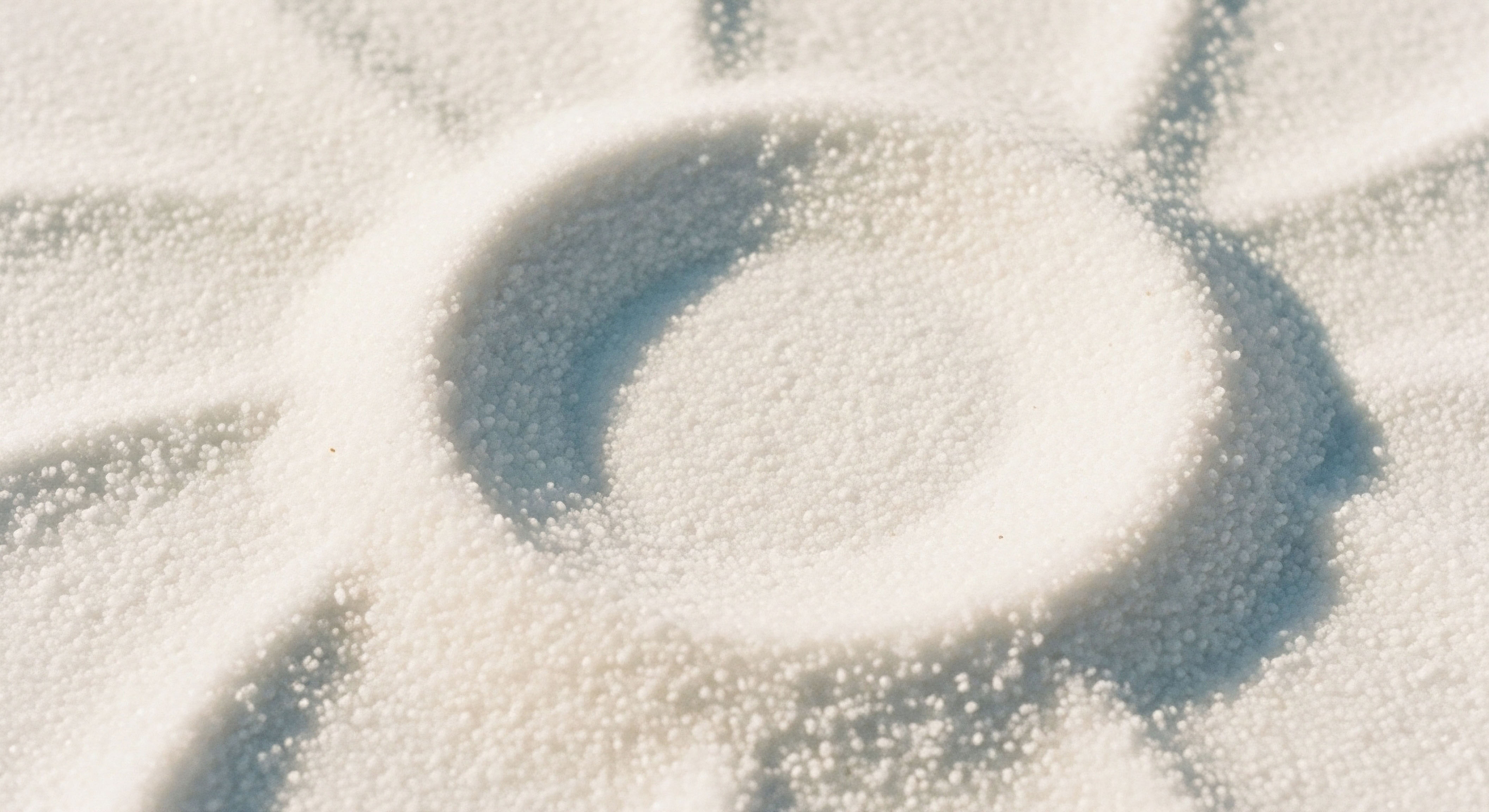

Fundamentals
The decision to cease testosterone replacement therapy introduces a profound question of biological autonomy. You have experienced the body functioning with optimized hormonal input, and now you stand at a crossroads, contemplating the path back to self-regulated production. The core of this issue lies in understanding the body’s intricate internal communication network, the Hypothalamic-Pituitary-Gonadal (HPG) axis.
This system functions like a highly sophisticated thermostat, constantly monitoring and adjusting testosterone levels to maintain equilibrium. The hypothalamus, in the brain, senses the need for more testosterone and sends a signal, Gonadotropin-Releasing Hormone (GnRH), to the pituitary gland. The pituitary, in turn, releases Luteinizing Hormone (LH) and Follicle-Stimulating Hormone (FSH) into the bloodstream. These hormones travel to the gonads, instructing them to produce testosterone.
Introducing testosterone from an external source sends a powerful message to this regulatory system. The hypothalamus detects ample testosterone and ceases its GnRH signals. Consequently, the pituitary goes quiet, and the entire production line downstream halts. The system becomes dormant, relying on the external supply. Abruptly removing that supply creates a vacuum.
The internal production machinery is still offline, leading to a period where testosterone levels can fall significantly. This biochemical state manifests in the very symptoms that likely prompted the initial therapy ∞ a pervasive fatigue, shifts in mood, a decline in muscle mass and strength, and a noticeable drop in libido. Your body is left waiting for a signal that it has been conditioned to ignore.
Abruptly stopping testosterone therapy creates a hormonal void, as the body’s natural production axis remains dormant from prolonged external signaling.
This is where the conversation about lifestyle begins. Strategic interventions in nutrition, exercise, sleep, and stress management are the foundational elements of endocrine health. They provide the raw materials and the optimal environment for your body’s hormonal systems to function. A diet rich in specific micronutrients provides the building blocks for hormone synthesis.
Specific types of physical activity can send a potent signal to the HPG axis, encouraging it to awaken. Prioritizing sleep and managing stress protects the entire system from the disruptive influence of hormones like cortisol. These lifestyle factors are the essential groundwork for any attempt to restore natural function.

What Does the Body Experience When Exogenous Testosterone Is Removed?
Upon the sudden cessation of external testosterone, the body enters a state of acute hormonal deficit. The immediate experience is often a direct reversal of the benefits the therapy provided. Energy levels may plummet, cognitive focus can become diffuse, and a sense of vitality may be replaced by lethargy and irritability.
This is the physiological consequence of the HPG axis’s suppression. Without the external testosterone it has become accustomed to, and with its own production facilities still offline, the body’s systems that depend on testosterone begin to operate at a diminished capacity. This includes the regulation of metabolism, which can lead to an increase in body fat, particularly around the abdomen, and a concurrent loss of lean muscle tissue.
The psychological impact is just as significant. Testosterone is a powerful modulator of neurotransmitter systems in the brain that regulate mood, motivation, and confidence. The sudden absence of this influence can precipitate feelings of anxiety or a depressive state. It is a challenging biological transition.
The body must first recognize the deficit and then slowly begin the process of restarting its own production. This process is variable and depends on numerous factors, including the duration of the therapy, the dosage used, and your underlying physiological health. Lifestyle interventions become the primary tool to support the body through this recalibration period, providing the resources needed for the HPG axis to gradually come back online.


Intermediate
To appreciate the role of lifestyle modifications in the post-TRT environment, one must first understand the precise mechanics of the hormonal feedback loop. The introduction of exogenous testosterone effectively tranquilizes the HPG axis through negative feedback. High levels of circulating androgens are detected by receptors in both the hypothalamus and the pituitary gland.
This detection suppresses the pulsatile release of GnRH from the hypothalamus. Without this primary signal, the pituitary’s gonadotroph cells reduce their output of LH and FSH, the very messengers that stimulate the Leydig cells in the testes to produce testosterone and Sertoli cells to support spermatogenesis. The result is a system in hibernation, which can lead to a reduction in testicular volume and a complete halt of endogenous androgen production.
The challenge of stopping therapy is to reawaken this dormant axis. Lifestyle interventions function as powerful signaling inputs that can help encourage this process. They do so by creating a biological environment conducive to hormonal production and by directly influencing the key players in the endocrine system.
These are not passive wellness activities; they are targeted biological strategies aimed at restoring a complex internal system. The effectiveness of these strategies, however, is contingent on their specificity and consistency. While they can provide significant support, the degree to which they alone can mitigate the effects of abrupt cessation depends heavily on the level of suppression the HPG axis has experienced.

Strategic Lifestyle Interventions for Endocrine Support
A targeted approach to lifestyle is essential for supporting the endocrine system’s recovery. Each choice in diet, exercise, and daily rhythm sends a distinct signal to the body, influencing hormonal pathways.

Nutrition as a Hormonal Precursor
The body requires specific raw materials to synthesize testosterone. A diet lacking these essential components handicaps the production process from the start. Key micronutrients are particularly important.
- Zinc ∞ This mineral is directly involved in the enzymatic processes that produce testosterone. It also plays a role in the function of the pituitary gland, helping to regulate the release of LH. A deficiency in zinc is directly correlated with lower testosterone levels.
- Vitamin D ∞ Functioning as a steroid hormone itself, Vitamin D receptors are found on cells throughout the HPG axis, including in the testes. Adequate levels are associated with healthier testosterone production.
- Healthy Fats ∞ Cholesterol is the direct precursor molecule from which all steroid hormones, including testosterone, are synthesized. A diet with sufficient healthy fats from sources like avocados, nuts, and olive oil provides the fundamental building blocks for hormonal recovery.

Exercise as an Endocrine Stimulant
Physical activity is a potent modulator of the endocrine system. The type of exercise performed determines the hormonal response.
Resistance training, particularly involving large muscle groups through compound movements like squats and deadlifts, has been shown to create an acute post-exercise increase in androgen receptor density and testosterone levels. This type of stimulus sends a powerful signal to the body that there is a demand for anabolic processes, which can help prompt the HPG axis to respond.
Conversely, excessive, prolonged endurance exercise can elevate cortisol levels, a stress hormone that has an antagonistic relationship with testosterone. Chronically high cortisol can suppress the HPG axis, working against the goal of restoration.

How Do Specific Nutrients and Exercise Modalities Influence HPG Axis Recovery?
Specific nutrients and forms of exercise exert direct biochemical influences that can aid in restarting the HPG axis. For instance, magnesium plays a role in modulating the bioavailability of testosterone by affecting Sex Hormone-Binding Globulin (SHBG). Higher levels of free testosterone are more biologically active.
High-intensity interval training (HIIT) has also been shown to be effective at boosting testosterone without the prolonged cortisol elevation associated with chronic cardio. The goal is to create a hormonal environment that is low in catabolic signals (like cortisol) and high in anabolic demand.
Targeted lifestyle inputs, such as specific nutrient intake and resistance training, act as direct signals to encourage the reawakening of the dormant HPG axis.
The table below outlines some of these targeted interventions and their physiological mechanisms.
| Intervention | Physiological Mechanism of Action |
|---|---|
| Resistance Training (Compound Lifts) | Increases androgen receptor density and sends a powerful anabolic signal, stimulating demand for endogenous testosterone production. |
| Adequate Sleep (7-9 hours) | Maximizes the natural nocturnal pulse of LH and testosterone release and minimizes the production of cortisol, which suppresses the HPG axis. |
| Stress Management (e.g. Meditation) | Lowers circulating cortisol levels, preventing the suppression of GnRH at the hypothalamus and reducing the “theft” of hormonal precursors. |
| Sufficient Dietary Cholesterol | Provides the essential molecular backbone (pregnenolone) required for the synthesis of testosterone in the Leydig cells. |
While these lifestyle factors create the ideal conditions for recovery, their ability to single-handedly overcome the profound suppression from long-term TRT is limited. For many individuals, the HPG axis requires a more direct pharmacological stimulus to effectively restart, a topic explored in the next section.


Academic
From a clinical standpoint, relying solely on lifestyle modifications to restart a significantly suppressed Hypothalamic-Pituitary-Gonadal (HPG) axis after prolonged testosterone therapy presents a substantial challenge. The duration and dosage of exogenous testosterone administration are critical variables that correlate with the degree of HPG axis suppression and the time required for recovery.
In many cases, especially after months or years of therapy, the axis requires a direct pharmacological intervention to overcome its induced inertia. This is accomplished through a protocol often referred to as a “restart” or Post-Cycle Therapy (PCT), which utilizes specific medications to stimulate the endocrine system at different points along the axis.
This approach views lifestyle as a synergistic and essential foundation, preparing the body for a successful restart and helping to maintain function once it is achieved. The pharmacological agents provide the targeted and potent stimulus needed to overcome the deep negative feedback inhibition. The goal is to sequentially and logically re-engage each component of the axis, from the pituitary gland down to the Leydig cells of the testes.

Pharmacological Interventions for HPTA Restart
A medically supervised restart protocol is designed to actively restore endogenous testosterone production. This typically involves a combination of compounds that work on different mechanisms within the HPG axis.

Selective Estrogen Receptor Modulators (SERMs)
SERMs are a cornerstone of HPG axis restart protocols. Compounds like Clomiphene Citrate and Tamoxifen Citrate function by acting as estrogen antagonists at the level of the pituitary gland. Estrogen, like testosterone, exerts negative feedback on the pituitary. By blocking these estrogen receptors, SERMs effectively blind the pituitary to the circulating estrogen, causing it to perceive a hormonal deficit.
In response, the pituitary increases its production and secretion of Luteinizing Hormone (LH) and Follicle-Stimulating Hormone (FSH). This elevated LH level is the primary signal required to stimulate the testes to resume testosterone production. Clomiphene has demonstrated significant efficacy in this role, with studies showing its ability to substantially increase testosterone levels after a course of treatment.

Human Chorionic Gonadotropin (hCG)
Human Chorionic Gonadotropin is a hormone that functions as an analogue of LH. It directly stimulates the LH receptors on the Leydig cells within the testes, prompting them to produce testosterone. This is particularly useful for preventing or reversing the testicular atrophy that can occur during long-term TRT.
Its use can be twofold ∞ some protocols incorporate low-dose hCG during TRT to keep the testes functional, which may lead to a faster recovery post-cessation. Alternatively, it can be used at the beginning of a restart protocol, just after testosterone administration has stopped, to “prime the pump” and ensure the testes are responsive before stimulating the pituitary with SERMs.

Can Medically Supervised Protocols Overcome Prolonged HPG Axis Suppression?
Yes, for a majority of individuals, a well-designed, medically supervised protocol can successfully restore HPG axis function. The success rate is high, with one study indicating that approximately 80% of individuals achieved satisfactory recovery of the HPG axis after a three-month period of cessation combined with a PCT protocol.
The protocol’s design depends on the individual’s specific context, including the duration of TRT and the type of testosterone ester used. For example, after a final injection of a long-acting ester like Testosterone Cypionate, a waiting period is necessary before initiating the restart protocol to allow the exogenous hormone to clear the system.
Pharmacological restart protocols use targeted medications to actively stimulate the pituitary and testes, overcoming the deep suppression induced by long-term testosterone therapy.
The following table compares the primary pharmacological agents used in HPG axis restart protocols.
| Compound | Mechanism of Action | Primary Clinical Objective | Typical Protocol Duration |
|---|---|---|---|
| Clomiphene Citrate (Clomid) | Acts as an estrogen antagonist at the pituitary, increasing LH and FSH secretion. | To stimulate the pituitary gland to send signals to the testes, restarting the entire axis. | 4-6 weeks, often with a tapering dose. |
| Tamoxifen Citrate (Nolvadex) | Also an estrogen antagonist at the pituitary, with a similar but distinct profile to Clomiphene. | Often used for pituitary stimulation, sometimes considered to have a more favorable side effect profile. | 4-6 weeks, used alone or in combination. |
| Human Chorionic Gonadotropin (hCG) | Mimics LH, directly stimulating the Leydig cells in the testes. | To restore testicular sensitivity and volume, and directly initiate testosterone production. | Typically used for 2-4 weeks before starting SERMs. |
| Anastrozole (Aromatase Inhibitor) | Blocks the conversion of testosterone to estrogen. | To manage estrogen levels and prevent estrogenic side effects during the restart process. | Used as needed based on symptoms and lab work. |
A comprehensive approach integrates these pharmacological tools with the foundational support of lifestyle changes. The lifestyle factors optimize the body’s overall health, reduce inflammation, and provide the necessary precursors for hormone production, while the medications provide the direct, powerful stimulus needed to bring the dormant HPG axis back to full function.
- Phase 1 Cessation and Washout ∞ The individual stops all exogenous testosterone. A waiting period of several days to weeks ensues, depending on the ester length of the testosterone used, to allow blood levels to fall.
- Phase 2 Testicular Priming (Optional but Recommended) ∞ A short course of hCG is administered to directly stimulate the testes, ensuring they are responsive to the upcoming pituitary signals.
- Phase 3 Pituitary Stimulation ∞ A SERM, such as Clomiphene or Tamoxifen, is initiated. This blocks estrogenic feedback at the pituitary, driving up the production of LH and FSH.
- Phase 4 Monitoring and Tapering ∞ Hormone levels are monitored through blood tests. The SERM dosage may be tapered down as the body’s natural production becomes more robust and self-sustaining.

References
- Lykhonosov, M.P. et al. “Peculiarity of recovery of the hypothalamic-pituitary-gonadal (hpg) axis, in men after using androgenic anabolic steroids.” Problems of Endocrinology, vol. 66, no. 4, 2020, pp. 59-67.
- “The use of post-cycle therapy is associated with reduced withdrawal symptoms from anabolic-androgenic steroid use ∞ a survey of 470 men.” Hormones and Behavior, vol. 118, 2020, 104634.
- “Clomiphene citrate and human chorionic gonadotropin are both effective in restoring testosterone in hypogonadism ∞ a short-course randomized study.” BJU International, vol. 116, no. 5, 2015, pp. 804-9.
- Rahnema, C. D. et al. “Anabolic steroid-induced hypogonadism ∞ diagnosis and treatment.” Fertility and Sterility, vol. 101, no. 5, 2014, pp. 1271-9.
- Katz, D. J. et al. “Outcomes of clomiphene citrate treatment in young hypogonadal men.” BJU International, vol. 110, no. 4, 2012, pp. 573-8.
- Coward, R. M. et al. “Restoring fertility in the hypogonadal patient ∞ a systematic review.” American Journal of Men’s Health, vol. 9, no. 3, 2015, pp. 229-37.
- Wheeler, K. M. et al. “A review of hormonal replacement therapy in men.” Journal of the American Academy of Physician Assistants, vol. 29, no. 5, 2016, pp. 22-7.
- Traish, A. M. et al. “The dark side of testosterone deficiency ∞ I. Metabolic syndrome and erectile dysfunction.” Journal of Andrology, vol. 30, no. 1, 2009, pp. 10-22.

Reflection
The information presented here provides a map of the biological territory you are considering navigating. It details the intricate systems of internal communication, the consequences of their interruption, and the tools available to encourage their restoration. This knowledge is the first step. It transforms uncertainty into a series of understandable, addressable physiological processes. The path forward is a deliberate act of engaging with your own biology. It is a dialogue between your choices and your body’s response.
Consider this a framework for a conversation with a qualified clinician. Your personal history, your specific protocol, and your unique physiology will define the optimal path. The ultimate goal is to build a resilient, self-regulating internal system that supports your vitality and function.
The journey off of hormonal support is as personal and requires as much diligence as the decision to begin it. You are now equipped with a deeper understanding of the “why” behind the process, empowering you to take proactive, informed steps toward reclaiming your body’s innate capacity for balance.

Glossary

luteinizing hormone

testosterone levels

gnrh

hpg axis

exogenous testosterone

negative feedback

leydig cells

endocrine system

pituitary gland

testosterone production

testosterone therapy

post-cycle therapy

endogenous testosterone

clomiphene citrate




